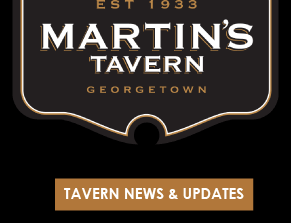

|
It's Time for Lunch at Martin's Tavern
March 27, 2009 Eat 5 Lunches and Get 1 Free! Thanking our Customers July 16, 2009 In celebration of 75 years of service, Martin's Tavern hosted a special day for customers by rolling back prices to 1934. Martin's Tavern Gift Cards May 22, 2009 Give the gift of great food and friends with a Martin's Tavern gift card! Martin's Tavern Featured on WUSA-9 June 3, 2009 Click here to read the story and watch Billy reminisce on 75 years of tradition! Martin's Celebrates 75 years with Willard Scott! 6/9/2009 Donation Request Form November 19, 2009 Please visit the "Contact Us" page to fill out the donation request form |

CELEBRATING MARTIN’S 75TH ANNIVERSARY
Martin’s Tavern celebrates its 75th anniversary this year. We are proud to be one of the few Washington, D.C. establishments at the heart of the city since the Great Depression. Throughout the changing times, Martin’s Tavern is unique in giving presidents and plain-folk alike a welcoming atmosphere carried by Martin’s long-tenured staff & family and sensible food & spirits that patrons themselves have personally requested.
There have been seven and half decades of outstanding cooks at Martin’s and legacy service people. Our family insists on being gracious hosts to anyone who walks through our doors. Prices have respectfully remained modest and Martin’s simple formula of making customers happy has delivered 75 years of continuous and humble success.
In this unique atmosphere, patrons naturally engage with each other in the spirit of the city; familiar neighborhood faces mixing with the most powerful names in Washington and popular culture ensure a genuine dialogue and friendship amongst all. It is this classic characteristic of Martin’s Tavern’s staff and patrons that brought monumental figures such as Harry Truman, John F. Kennedy, Lyndon Johnson and even Richard Nixon to hold court in Martin’s booths. Our tradition of hospitality to has brought every sitting president from Harry Truman to George W. Bush to the tables of our tavern.
HISTORY OF THE MARTIN FAMILY
In the late 1890s, William S. Martin traveled from Galway, Ireland to America. Forty years later, he and his son, William G. Martin, opened Martin’s Tavern on the corner of Wisconsin Avenue and N Street NW.
It was 1933, in the midst of the Great Depression and the beginning of the Repeal of Prohibition. William G. Martin, a recent graduate of Georgetown University, was beginning a prodigious career in professional baseball, football and basketball. Successful in business and sports, he earned a seat as a Hall-of-Famer.
In 1949, William G. Martin’s son, William A. Martin, joined the Tavern after serving in the Navy during World War II. William A. Martin attended Georgetown University Medical School, and excelled as a Golden-Gloves boxer and Pro-Am golfer. His stories of “The Dugout”, recalling countless meetings with Speaker Sam Reyburn, Senator Lyndon Johnson, and other monumental Capitol Hill leaders, were passed on to his son, current owner Billy Martin.
HISTORY of GEORGETOWN
In the late 19th century through the early 20th century, Georgetown remained a blue collar laborers’ port, transporting goods in and out of the Washington region. The Martin family was at the heart of the community, familiar with the many that resided, labored and traveled in Georgetown, setting the tone and spirit of Martin’s Tavern.
Georgetown was the farthest navigable point up the Potomac River for ocean-going boats. After the American Revolution, Georgetown became an independent municipal government of the federal District of Columbia, along with the City of Washington, the City of Alexandria, and the newly created County of Washington and County of Alexandria (now Arlington County, Virginia). It was officially known as "Georgetown, D.C." In 1862, the Washington and Georgetown Railroad Company began a horsecar line running along M Street in Georgetown and Pennsylvania Avenue in Washington, easing travel between the two cities. Georgetown's corporate charter, along with Washington's, was formally revoked by Congress effective June 1, 1871, at which point its governmental powers were vested within the District of Columbia. The streets in Georgetown were renamed in 1880 to conform to the street names in Washington.
By the late 1800s, flour milling and other industries in Georgetown were declining, partly due to the fact that the canals and other waterways continually silted. A flood in 1890 with expansion of railroads brought destitution to the C&O Canal. Georgetown became a depressed slum, with alleys choked by tiny dwellings lacking plumbing or electricity.
Shipping trade vanished between the Civil War and World War I. As a result of this departure, many older homes were preserved relatively unchanged. Alexander Graham Bell's earliest switching office for the Bell System was located on a site just below the C&O Canal, three blocks from Martin’s Tavern, where it remains in use as a phone facility to this day.

